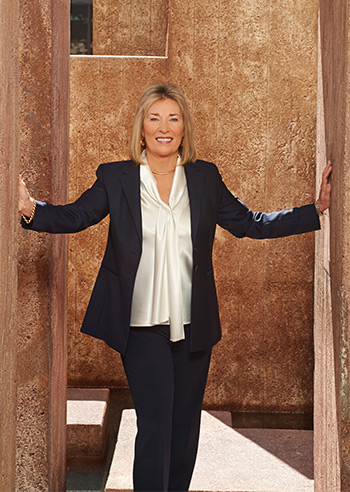Delivering hands-on retirement expertise
Delivering hands-on retirement expertise

Patricia Cathey • Denver, CO
Brokers International Financial Services LLC
Read full biography below
I have been working in the health and life segment of the insurance industry for many years. I was actually the first woman that a major insurance company hired here in the Denver area. I have worked on several different sides of the business, starting in personal sales, then commercial sales, and progressing to brokerage manager for a large insurance marketing firm. I started my own wholesaling and marketing firm in 1993.
With all of the changes coming through the health-care area, we decided to switch focus a few years ago to more of a specialty in senior health products related to Medicare. I currently work with 40-50 agents and do everything possible to facilitate their business in terms of new products, the latest industry information, sales training, and consultative marketing.
Throughout my career I have always been very interested in investments, both on a personal level and how that relates to the overall financial picture for people approaching or in retirement. With my knowledge of the life and health benefits side of the equation, as well as taxes and issues related to retirement, I thought it would be a natural next step to add an investment advisory capability. So, I am currently functioning as both a principal owner in the insurance wholesaling area and building up my separate advisory practice.

My parents were both numbers people. My mother was an accountant and my father was a loan officer with the Veterans Administration. I was brought up with a conservative outlook surrounding investments and money management. For my parents that meant very conservative: CDs back when they actually delivered some returns. I was personally indoctrinated in the theory of conservative portfolio diversification, with money allocated to equities being allowed to grow over time through passive buy-and-hold investing. Unfortunately, what was being touted as a conservative and traditional route to investing did not serve me particularly well in the early 2000s.
I definitely learned the lesson that trying to achieve solid returns in the equity market has to be accompanied by close attention to risk management. I decided the old theories of investment management were not working for me and went on an exhaustive search for new investing solutions. I read extensively, joined a very knowledgeable peer group, and studied technical analysis. When I did get my Series 65, it was natural for me to gravitate toward tactical third-party managers who implemented quantitative investment strategies and focused on risk management. I am very pleased with this decision and think it works for me as an advisor and for my clients.
My advisory practice will be focused on a relatively small number of clients, near or in retirement most likely, and with above-average net worth. But whether that client is a small-business owner who just sold their business, or a recently widowed older female, or a couple looking to live an active and comfortable retirement lifestyle, protection of capital has to be a major consideration.
For these types of people, losing 30% to 40% of their investable assets in one year is just not a viable option. Yet that is exactly what has happened to equity markets twice in the period of 10 years. It seems incumbent upon me as an advisor to provide solutions that can provide for slow and steady asset growth, yet always keep an eye on the risk side. The sequence-of-returns issue is not just an investment theory; it is something clients have to understand at a basic level.
Active investment management is built in many ways around that issue and provides the type of investment strategies that can keep clients committed to their investment plan through good times and bad. One of the major roles that a good investment advisor provides is helping clients have the confidence to stay in the market, so they can take advantage of positive market conditions and growth when it occurs. My goal is to try to find ways to smooth out volatility and reduce downside exposure as much as possible.
 It is one of the most interesting and important parts of my job as an advisor. My broker-dealer has been excellent in terms of identifying money managers I should be looking at, and a specific individual there initially guided me through the process. They also periodically have conferences where several money managers, or aggregators of managers, are brought in to present their specific programs and methodologies. From there, we have narrowed it down to a handful that I think are appropriate for my client base and drilled down into their specifics.
It is one of the most interesting and important parts of my job as an advisor. My broker-dealer has been excellent in terms of identifying money managers I should be looking at, and a specific individual there initially guided me through the process. They also periodically have conferences where several money managers, or aggregators of managers, are brought in to present their specific programs and methodologies. From there, we have narrowed it down to a handful that I think are appropriate for my client base and drilled down into their specifics.
It culminates with a personal meeting with the money manager’s representatives to talk in detail about the strategies that are available and the ins and outs of how they are implemented and monitored. It is about making sure we are aligned philosophically and that they have the products and services that will meet my clients’ needs. One of the most important factors is looking at their strategy results in various types of market conditions. Have their strategies performed according to their specific objectives? Have they worked for a long time? Have they worked through up markets and down markets? Obviously, I am looking for managers and strategies that participate as little as possible on the downside and capture gains as much as possible on the upside. However, it is not about trying to get the whole market gain—it is definitively more about the consistency of returns.
“The sequence-of-returns issue is not just investment theory—it is something clients have to understand at a basic level.”
There are several things I like to talk about. On the broadest level, a client needs to understand that we are not chasing the hottest returns of individual sectors or specific stocks that they may read about. A quantitative strategy will rotate among sectors and even asset classes, but it is not a discretionary call. It is letting the analysis, numbers, and trends dictate the decision-making of a model or system.
Second, and related to the first point, is that clients need to have a longer-term perspective on their investment approach. Strategies that deliver the highest returns in bull markets will generally also have the highest risk of significant drawdowns. If a client is asking why our strategy did not deliver a 30% annual return in a given bullish year, they need to realize that we also likely will not see a 30% loss in a very bearish year. Active managers have time-tested approaches that need to work over full market cycles, not just one quarter or a single year.
Third, although I definitely favor actively managed strategies, there are many different approaches within that universe. It is my role to help a client decide, based on their objectives, their risk appetite, and their life circumstances, what is the right strategy or combination of strategies that meets their specific needs. If circumstances change, or a strategy does not perform the way I think it should, I need to step in, assess the situation, and make adjustments as required. I keep a very close eye on how strategies are performing, and my clients appreciate the role I play in managing the managers.
 Patricia Cathey is an investment advisor representative based in Denver, Colorado, and is affiliated with Brokers International Financial Services LLC. She has more than 20 years of experience in the insurance and financial industry.
Patricia Cathey is an investment advisor representative based in Denver, Colorado, and is affiliated with Brokers International Financial Services LLC. She has more than 20 years of experience in the insurance and financial industry.
As owner and president of Brokers Access Corp., Ms. Cathey has been educating the insurance agent community and assisting them with client presentations and marketing for life, health, and annuity programs since 1993. Brokers Access is a national wholesaler of individual life and health insurance products. Additionally, it offers a full line of Medicare Advantage, Medicare supplements, and dental plans.
She recently transitioned to the retirement-planning arena and has since added investment advisory services to her practice. Ms. Cathey’s areas of expertise include Medicare products, pension planning, and retirement accumulation and distribution. She has been a seminar speaker on topics such as Social Security maximization and health-care-planning issues. She has also taught classes on Social Security strategies and other benefits topics for the Front Range Community College adult education program.
Ms. Cathey is a graduate of the University of Colorado, where she studied psychology and business. A Colorado native, she is an avid skier and cyclist and actively raises money for various charity cycling events. She is a member of the Colorado Financial Planning Association.
Disclosure: Patricia Cathey is an investment advisor aepresentative offering securities and advisory services through Brokers International Financial Services LLC. Member SIPC.
Photography by Stephen Collector

